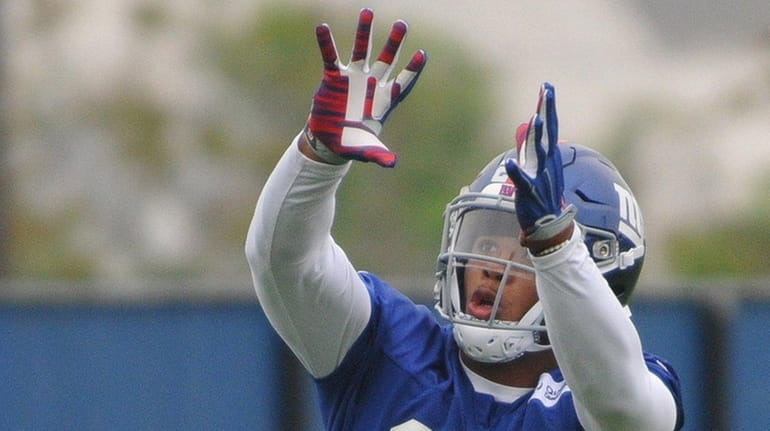Giants rookie RB Saquon Barkley likes to catch passes out of the backfield

Running back Saquon Barkley practices during the second day of Giants rookie minicamp held in East Rutherford, New Jersey, on Saturday, May 12, 2018. Credit: James Escher
Saquon Barkley became a good pass receiver essentially out of boredom.
He was in high school, already a star running back, and could not stand his role in the seven-on-seven offensive drills.
“If you’re a running back on seven-on-seven in the high school level, you don’t really do much, so I kind of hated that and I wanted to be a part of it,” Barkley said. “So they started doing things for me in the slot and lining me up wide and all of that kind of came together.”
That was in his junior season at Whitehall High School in Pennsylvania. It was a skill Barkley continued to hone at Penn State, where he caught 102 passes in three years, more than half of them (54) in the 2017 season.
And now he’s a Giants running back, which is probably the least accurate position name for what he’s been doing.
Since he showed up on the field for the Giants two weeks ago, the focus has been primarily on feeding Barkley the ball through the air. That may be because the teams are not yet in pads or equipment and players not yet tackling or really even blocking each other, so running plays are not valuable expenditures of practice time. But it’s more likely because the Giants want to use Barkley as a receiver out of the backfield.
“When you look at the great backs in the NFL right now . . . one thing that stands out to you is they all can run the ball, but the reason why they separate themselves from the rest of the pack is because they can catch the ball out of the backfield and they can do it on every single down,” Barkley said. “I want to try to get myself on that level first. Obviously, I have to handle what I have to handle here and focus on the playbook and getting better every single day, but as that continues to come, I have to continue to work on my route-running because if you have a running back that is able to run routes and is a threat out of the backfield, that is just another thing you have to cover.”
To that end, Barkley has been trying to glean as much advice as possible from Eli Manning (“I think I’m probably annoying to him a little bit, but I continue to ask him a lot of questions,” Barkley said) as well as Odell Beckham Jr.
“I used to talk to him when I used to train with him [before the draft] and be like, ‘How do you do this? How do you set that up?’ ” Barkley said of his work with Beckham. “Obviously, it’s different routes from him being out wide and me being in the backfield and maybe hopefully sometimes lining up in the slot. It’s different, but you can apply that to your route-running. You can apply it to how you set it up, how you bring it down, how you use your eyes, how you catch the ball. So I definitely talk to Odell.”
Tiki set the bar
Catching passes out of the backfield is far different from doing so from the fringes of the line of scrimmage. Tiki Barber, one of the top receivers among running backs in NFL history (his 586 career catches ranks second all-time among Giants at all positions), said it is more an art than a science.
“As a receiver, it’s all timing,” Barber said. “The quarterback is taking a five-step drop, so when he hits his five-step, [the receiver] needs to be at his break step. Same thing with seven-step. As a running back, you kind of have to feel what’s happening behind you, but you can’t see it. Some of that you pick up by watching defenders in front of you and easing your way into the right window.”
Barber started ducking behind imaginary defenders.
“Especially for small guys like I was, Eli is back here or Kerry Collins is back here, and if I’m standing here, you can’t see me,” he said. “So when I feel it breaking down, I have to slide to where there is visibility. You pick it up over time. You have to show yourself so that he can find you and get those checkdowns.”
Checkdowns, Barber said, don’t have to be passing forfeits. They can be weapons.
“Those checkdowns turn out to be big plays,” Barber said. “It’s found yardage, stolen yardage, when you have a running back who can, when a pass play breaks down, pick up 4 or 5 yards.”
Or, in some cases, more.
Natural receiver
Of course, the running back has to actually catch the ball. Not all of them can do it easily. The Giants haven’t had many in recent years who could. Not until Barkley.
“It kind of always came natural to me,” he said. “I think actually when you start to think about it is when you actually drop the ball. It’s with repetition and catching the ball every single day and using your eyes that it just comes naturally.”
Barkley recalled a play when his brain took over for his instincts and it resulted in an incompletion.
“In college, there was one play against Michigan and I ran a wheel and I actually was thinking about it, I was overthinking because I saw the safety coming and I was thinking about trying to beat him and what I was going to try to do before and I took my eyes off of it and I dropped it,” he said. “When you overthink sometimes, bad things happen.”
That goes for the Giants’ offensive plans for Barkley as well. Just as general manager Dave Gettleman said the team didn’t want to get “too cute” with the second overall draft pick last month, the play-calling likely will avoid too much gimmickiness when it comes to using Barkley.
At least at first. Things like lining him up in the slot or out wide, those may have to wait.
At least a little while.
“I definitely feel comfortable with catching the ball out of the backfield and lining up in the slot,” Barkley said. “Obviously, it’s very early in the offense and I’m just continuing to learn it, but for me to line up in the slot, I have to show the coaches that I can catch the ball out of the backfield first. I do feel comfortable doing that, but I have to make sure the coaches feel comfortable with me, so that’s every single day coming out here and every single rep. Work on my route-running, whether it’s in the slot or whether it’s in the backfield . . . As a running back, we’re well known for running the ball, and if you can catch the ball out of the backfield, maybe you take it to a 25-yard or a 60-yard touchdown.”
That would be anything but boring.

